long live the old flesh
cinematic embalming and AI mummies in cronenberg's the shrouds // which conclave character is which real-life papal candidate? (authoritative edition)
My goal with this newsletter is to write about new films as they reach general release, along with some seasonally appropriate commentary on other cinematic events and interests. This week we’ve got Cronenberg’s latest effort The Shrouds, plus some bonus Conclave-based conclave speculation. This newsletter comes out every Wednesday, which this week means Thursday.

"I don't think people realize David made another movie," sighed the woman at the box office as she printed off my ticket to The Shrouds. I think she's right: there were only four other people in the theater and this movie has yet to make $400,000. At age 82, Cronenberg isn’t gunning for any new fans, and true to form The Shrouds is incomprehensible and mostly unpleasant to watch. But Cronenberg has built an entire career on that paradigm. Even when his movies are unwatchable they at least give the world something to write about.
The central idea here is the titular shroud, a winding sheet embedded with cameras that creates a live, 3D representation of a rotting corpse. Tesla-driving tech entrepreneur Karsh (Vincent Cassel) came up with this brilliant invention after losing his wife (Diane Kruger) to debilitating bone cancer. If you find the premise disgusting, then you’re aligned with the woman Karsh takes on a first date to his wife’s digital gravesite. The woman splits, and with her goes our only shot at an audience surrogate. Karsh, never once giving the appearance that he understands what a freak he is, has created a paradigmatic tech disruption: a device nobody asked for, designed to spy on things nobody needs to see.
A film centered on this concept sounds unnecessarily punishing, and for many it probably is. But there’s some heart here - or, at the very least, some coherent theory. At the risk of sounding like a freshman film student, I’m going to suggest that this movie about being embalmed in cameras is About Movies. And to take that great insight one step further, I’m going to enlist the help of the opening essay in André Bazin’s seminal text What is Cinema?, an essay about cinematic embalming.1
Bazin believes that representational art stems from the human desire to preserve the past, beginning with the mummy:
If the plastic arts were put under psychoanalysis, the practice of embalming the dead might turn out to be a fundamental factor in their creation. The process might reveal that at the origin of painting and sculpture there lies a mummy complex. The religion of ancient Egypt, aimed against death, saw survival as depending on the continued existence of the corporeal body […] To preserve, artificially, his bodily appearance is to snatch it from the flow of time, to stow it away neatly, so to speak, in the hold of life (10).
Bazin argues that our first works of art were attempts to immortalize life through representation, a project we got better and better at until perfecting it with photography. Cinema, Bazin argues, does photography one better by freeing the moment from its coffin: not just a mummy but a perfectly preserved and revivified corpse. The connection to The Shrouds is obvious. Cronenberg imagines a camera so advanced that it perfectly embalms the dead into the cinematographic record. Bazin operates on a metaphor, but Cronenberg takes it further, offering up cinema as live, 8K footage of rotting flesh.
As the film goes on, GraveTech’s ability to surveil creeps out of the tomb and into everyday life. Cronenberg suggests a cinema capable of capturing every aspect of the human person, recorded in full and transmitted in real time. As Karsh obsesses over footage of his beautiful, rotting wife, he fails to notice that the tech advances he’s funding are gradually embalming his entire life. The perfect escape from death: mummification via surveillance. This film is about grief, sure, but it’s also a neat metaphor about what we call life in the age of doorbell cameras and smartwatches.
So what does Cronenberg do with that metaphor? I think this is where he injects the complication of AI.
Cronenberg made some noise during the rollout of The Shrouds by proudly proclaiming his use of AI. He doesn't specify where or how, though you might be tempted to say he used it to write the script.2 However it shows up, Cronenberg’s admission casts a pall over his film. There's an eerie lifelessness to The Shrouds, a bunch of characters who don't seem to know what it means to interact with the living and instead process physical reality as a theoretical exercise. “I loved that body”: the mourner’s version of “I love you, alive girl”. Plots don’t line up; emotions don’t make sense. Even the bodies, alive and dead, look unpleasantly enhanced.
If I was to hazard a guess, I'd say one of Cronenberg’s AI-boosted moments comes in a scene when Karsh tries on one of his shrouds. We see a computerized recreation of Cassel’s naked body that scans into his muscles, imitating that creepy Body Worlds exhibit science museums forced on us in the 2000s. Whether it’s AI-generated or just digitally sculpted, we know that what we're looking at isn't real. That viewer experience is mirrored in the script when Cassel discovers that a series of tumors growing on his wife's bones are actually digital composites: someone has hacked the shroud and edited the image of her corpse to include a series of photoshopped growths.
The discovery points to the classic sci-fi conclusion that, alongside perfect surveillance, we've achieved perfect simulation. There is no way to tell the difference between reality and deepfake in a world of digital images. In achieving mastery of the represented world, we've lost all ability to trust in the reality we so obsessively represent. Again, Cronenberg seems to directly conjure Bazin:
[T]he logical distinction between what is imaginary and what is real tends to disappear […] Hence photography ranks high in the order of surrealist creativity because it produces an image that is a reality of nature, namely, an hallucination that is also a fact. The fact that surrealist painting combines tricks of visual deception with meticulous attention to detail substantiates this (16).
Karsh opts to live in that surrealist world. His ability to confirm facts via photography has been undercut by someone’s capacity to manipulate them. Instead of worrying too much about it, he accepts it. He’s more interested in a past life than a present one, even if true belief in that past is no longer possible.
Cronenberg, as is his wont, pushes this acceptance to its physical limits. At the risk of spoiling a movie that no one is going to see, we're eventually brought to wonder if a body revealed on the shroud cam is actually present - if it even exists at all. We know that hackers can produce a perfect simulation of a cancer, just as we know that Cronenberg's effects team can create a perfect simulation of a human body: how do we know that the body depicted on GraveTech camera shows isn’t just a (sur)realist recreation? Karsh, too haunted by reality to face it unmediated, refuses to dig into the ground to look.
In the end, the only person Karsh can love is a blind woman who experiences the world through haptic reality (demonstrated in the most uncomfortable "Can I touch your face?" scene since Dude, Where's My Car?). Cronenberg has always been a flesh guy, and at least one read of this film, so much of which takes place on screens, is that the only possibility for human connection comes through actual touch. In the case of your cancer-crumbled wife, that touch is high risk; the mortality of the body will always be a point of horror. But love is the necessity of reaching out and risking the crunch. I think this sort of explains the baffling final shot of this film: the fragility of touch is the only means of escaping the imagined fragility of the look. Inhumanity stems from our desire to watch the world crumble through a phone screen. Life only happens when we reach out with a tenderness that isn't afraid to break it.
Speaking of living corpses - has the world ever been more primed for a papal conclave? Not only is our gossip industry buzzing at historic highs, but we also got a Hollywood blockbuster last winter that taught the world the meaning of “sede vacante,” Conclave is over-simplistic and loose on the logistics, but you could do a whole lot worse for a primer on what the heck is happening in post-Francis Vatican politics. Vulture beat me to the punch, but with all due respect Nick Jones don’t know what he’s talking about. I read the Catholic trades, I've spent a lot of time inside a gossipy organization that makes all its decisions through leaderless voting, and I have an expert source - so here are my authoritative Conclave (2024) —> Conclave 2025 comparisons.3


Lawrence (Ralph Fiennes) = Pietro Parolin (Secretary of State).
Vulture got this one right: Ralph Fiennes would have been Pietro Parolin even if they didn’t share the role of top-ranking cardinal elector. Like Lawrence, Parolin is a not-particularly-charismatic administrative member of the core Francis team. I can’t speak to any crises in faith he may or may not be having, but he’s had a hand in pretty much every political controversy of Francis’s pontificate. Parolin's shot is significantly overrated; like Lawrence, he’ll be the one asking the next pope for his name, not the other way around.


Bellini (Stanley Tucci) = Matteo Maria Zuppi (Bologna).
Pretty one-to-one here: if they’d let Tucci use his Big Night accent to play Bellini as an Italian it would have been too obvious. Zuppi is the big-name progressive successor to Francis. Non-Catholic media vastly overestimates the liberalness of the Francis coalition, but Zuppi is fairly left-of-center even by New York media standards: pro blessing same-sex unions, pro women deacons, pro environmentalism. Like Tucci, he’ll enter the Conclave as a media favorite with a progressive coalition behind him, and like Tucci, he'll be too aligned with the Francis legacy to get the tiara.
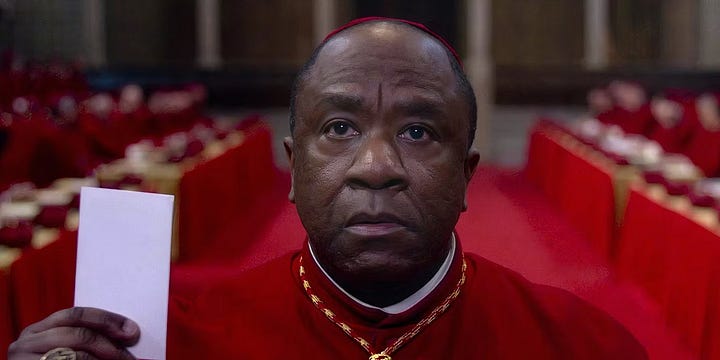

Adeyami (Lucian Msamati) = Fridolin Ambongo Besungu (Kinshasa).
Besungu's claim to fame is leading a continent-wide coalition against Francis's declaration concerning the blessing of “couples in irregular situations” in 2024 (the resolution of the conflict is actually pretty interesting and arguably ends up supporting another key Francis cause, synodolism - but you have already skipped on to the next sentence). He's not as famous as hardliner Robert Sarah (Prefect Emeritus of the Congregation for Divine Worship and the Discipline of the Sacraments), but it’s reasonable to expect that he‘s flexible enough for an African coalition to stand behind him. Ambongo's conservative enemies find him inconsistent, his progressive detractors considers him too harsh on social issues, and everyone seems to agree that he’s kind of sloppy - but a little bit of everything could be a solid path forward. Barring the revelation of a secret child, he’s a contender.
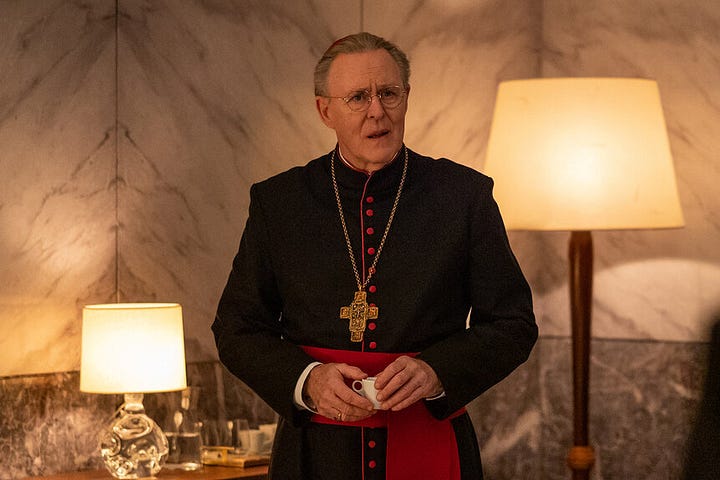

Tremblay (Jonathan Lithgow) = Marc Ouellet (Prefect Emeritus of the Dicastery for Bishops).
Like Tremblay, Ouellet is Canadian; like Tremblay, he’s a moderate conservative at the center of the Francis administration, the (now retired) head of HR for the entire global church. Ouellet is generally considered affable, and he’s definitely had his fingers in everybody’s files. He’s most famous for shouting down now-excommunicated Cardinal Carlo Viganò during the 2018 Viganò letter/McCarrick scandal, probably the juiciest thing to happen in Francis’s tea-splattered papacy. He’s somewhat less famous for his involvement in an incomprehensible scandal with a French nun that ended in a $200,000 wrongful-termination suit. Ouellet did the terminating, but he publicly stated that he was acting on orders of the Holy Father. Sound familiar? This guy loves the mess. He’s a lower-tier papabile, but his ability to play both sides could get him somewhere if he can keep his skeletons locked inside their closets.
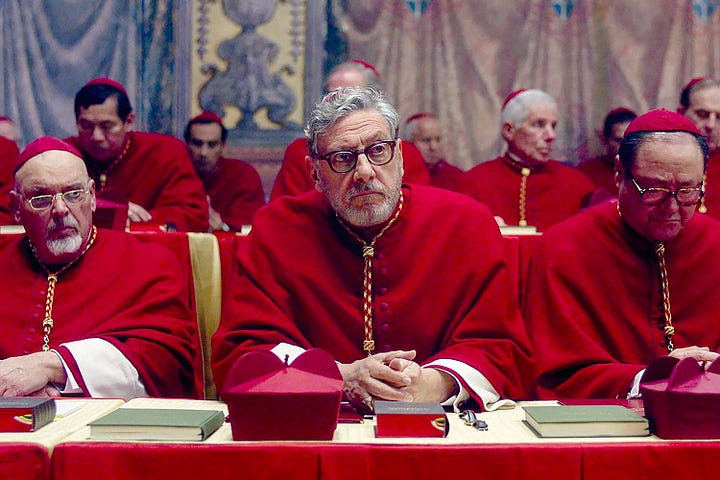
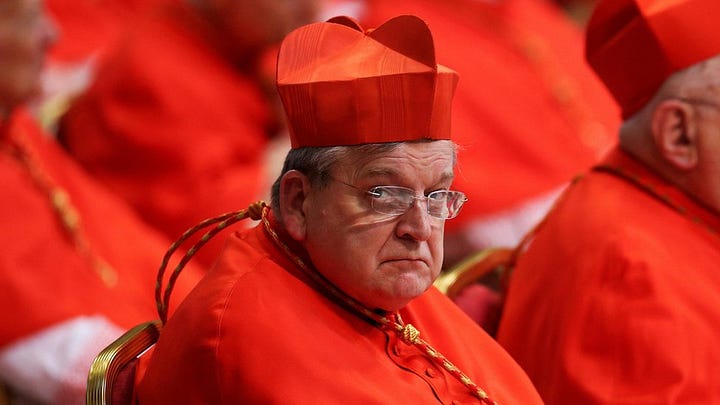
Tedesco (the Italian with the vape) = Raymond Burke (Prefect Emeritus of the Supreme Tribunal of the Apostolic Signatura).
Charismatic Francis-hating took a big hit when Viganò entered his life of prayer and penance. But Cardinal Burke of Wisconsin was the leading voice of edgelord traditionalism in the early days of the Francis pontificate; he got shipped off to a ceremonial post in Malta for his efforts and was ultimately stripped of his duties in 2023 (at least somewhat related to a controversy about condoms). No matter what Fox News says, he has no chance in any plane of existence of becoming pope, but he's the closest comparison to the obnoxious, high-church figure represented by Tedesco. Thankfully, the Catholic Church isn’t a popular democracy - shitposting only gets you so far when you’re trying to get a roomful of guys with passionate opinions about stuff like the individualist reductionism of the Pelagian tendency to vote for you.
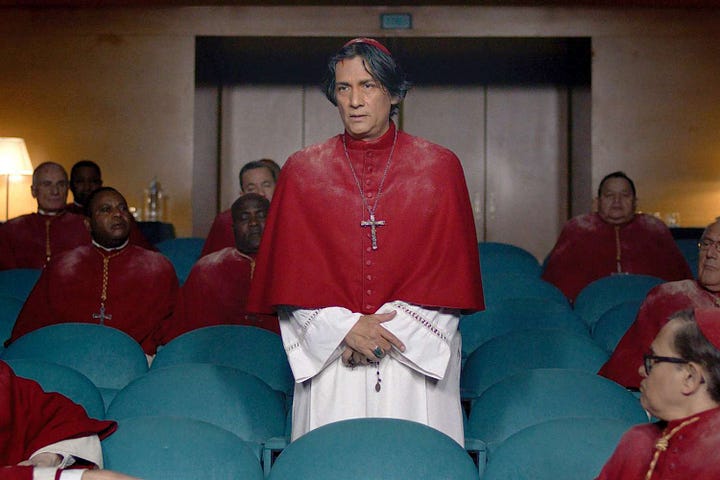
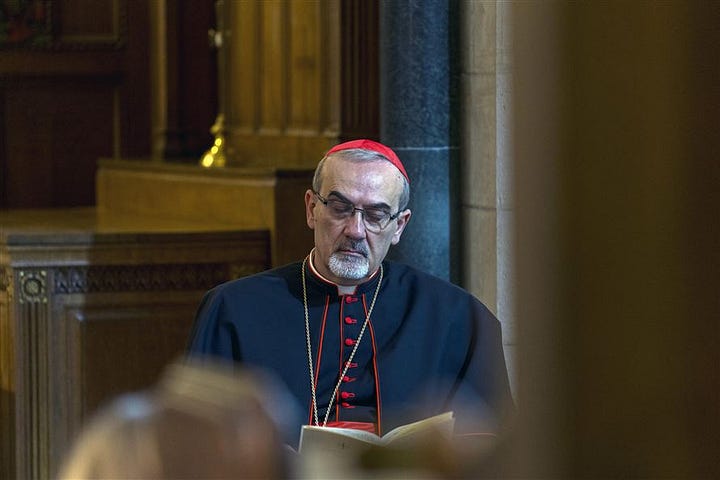
Benitez - Pierbattista Pizzaballa (Jerusalem).
You want to align dark-horse winner Benitez with fan-favorite Luis Antonio Tagle (Pro-Prefect of the Dicastery for Evangelization), but Tagle is a.) a front-runner, b.) based in Rome, and c.) publicly aligned with Francis. The real Benitez analogue is Pierbattista Pizzaballa: a young (60!), ideologically vague appointee to the Middle East whose ministry is focused on maintaining Christian charity in a conflict zone. I doubt he is secretly an intersex person appointed by Francis to prank the curia - but I know for a fact that he's made a lot of speeches about universalism after bombings carried out by people who many of his colleagues label fundamentalist terrorists. I'm not an expert, but if movies are as good at depicting papal politics as they are healthy romantic relationships and physics then I'm telling you - this guy could be pope.
Thanks for reading *life is disappointing.* If you found this newsletter slightly less disappointing than the rest of your life, consider liking, commenting, pledging me money (thanks!), or subscribing. Subscribing will get you exactly what you get here but sent to your email inbox. I refuse to see Thunderbolts*, but I’ll0 be back next week with something - maybe The Surfer? We’ll see what happens.
When I started writing this I could only find a couple mentions of this connection, but it seems to be spreading - and now semi-confirmed by Cronenberg himself. The essay is called “The Ontology of the Photographic Image,” and you can read it in André Bazin’s What is Cinema?, translated by Hugh Gray (University of California, 1967).
Cronenberg scripts are always bizarre, but this one is really something. At one point there’s a completely unhinged conversation between a dog groomer and a blind woman about the logistics of taking a seeing-eye dog to an off-leash dog park that I struggle to imagine a human being writing and then including in the film. There's also a bizarre fixation on Budapest and Hungary, locations that are stated and restated constantly throughout the film, including the final line. I'm not saying AI actually wrote this film, but the inhumanity of the script seems even more intentional than usual.
For real news on what’s happening in the Vatican and solid analysis on the upcoming conclave, check out The Pillar, John L. Allen, Jr.’s excellent work at Crux Now, and the somewhat fascist but very well-organized College of Cardinals Report. Also, thanks to my very knowledgeable brother, who is too serious a person to have his name attached to this stupid list.






This was an amazing journey: a gruesome elbow-crawl through a cinematic metaphor that proves worth elucidating -- at least on paper -- to a soap-bubble romp through a pending papal conclave. I feel lemon-fresh!